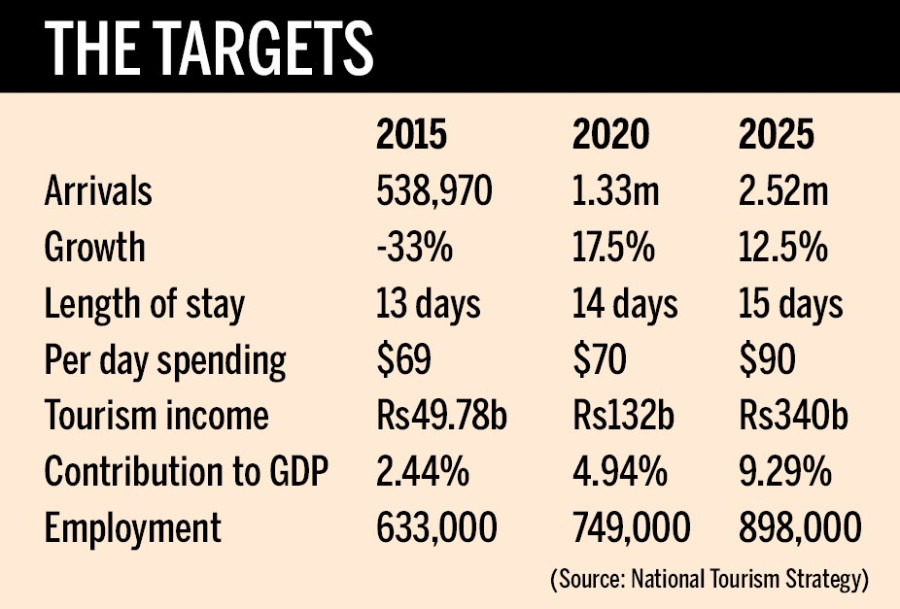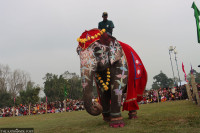Money
Nepal tourism sets goal to boost arrivals fivefold
The Tourism Ministry has launched the new National Tourism Strategy 2016-2025 which envisages a fivefold increase in arrivals to 2.52 million annually by the year 2025.
Sangam Prasain
The Tourism Ministry has launched the new National Tourism Strategy 2016-2025 which envisages a fivefold increase in arrivals to 2.52 million annually by the year 2025.
The scheme, which incorporates a five-year action plan and a 10-year horizon for the country’s tourism sector, has recommended a budget of Rs6.44 billion to implement the action plan. One-fourth of the funding is expected to be spent in the first and second years and one-fourth during each of the remaining three years. “The strategy was implemented officially after being endorsed by the Cabinet’s Economic and Infrastructure Committee recently,” said Ghanshyam Upadhyay, spokesperson for the ministry.
“The objective of the strategy is to increase tourist numbers, stay and income,” he said. “Nepal needs to make a number of improvements on the branding, infrastructure and quality fronts to attain the target set by the strategy.” Ordinarily, the strategy is not ambitious, but in the context of tourism growth in India and China and political uncertainty in Nepal, the strategy is ambitious and it will be difficult to achieve the target, the strategic document said.
The tourism strategy calls for improving the investment climate, encouraging foreign investment and promoting public-private partnership, improving air transport capacity and infrastructure and reforming government policies and acts to produce the desired result.
The strategy has set 11 special strategies for the overall development of the tourism sector—branding target, marketing target, focused programmes and development target, tourism economy, improvement of business investment target, human resource development, infrastructure development target, improvement of tourism quality, reforms in institutional and management, conservation of cultural heritage and zero carbon target. The strategy, which was developed with the technical assistance of Samarth-NMDP, has set a target to boost the average tourist length of stay to 15 days from the current 13 days and spending to $90 per tourist from $68.57 in 2015.
Likewise, the strategy has envisaged increasing foreign exchange earnings from the tourism sector to Rs340 billion annually from Rs49.78 billion in 2015. The tourism sector’s contribution to the country’s GDP has been projected to jump 9.29 percent from the existing 2.44 percent in 2015.
Similarly, the strategy has projected an increase in jobs in the tourism industry to 898,000 from 633,000 in 2015. Employment in the tourism industry and future projections are based on the report published by the World Travel and Tourism Council.
The government’s Tourism Employment Survey 2014, has shown that tourism industry provides direct employment to 138,000 people. The strategy said that the government’s statistics on the employment number was nominal and hence it did not provided sufficient base to figure out its future growth.
The strategy said that last year’s earthquake could have long-term effects on the country’s tourism sector as arrivals in 2017 could reach 2014 levels. Tourist arrivals to Nepal plunged to a six-year low of 538,970 in 2015 as the April 25 earthquake and subsequent Tarai unrest kept visitors away. According to the strategy, Nepal receives 0.1 percent of global tourist arrivals and 5.7 percent in the South Asian region. It receives 0.03 percent of the income tourists spend globally and 1.4 percent in South Asia. The strategy has pointed out that Nepal is one of the cheapest tourist destinations in the world.
The document has said that Nepal should be clear about whether it wants to attract high-end visitors or focus on mass tourism. However, it should never be a destination for a small number of tourists who spend little money.




 18.12°C Kathmandu
18.12°C Kathmandu













%20(1).jpg&w=300&height=200)
